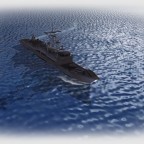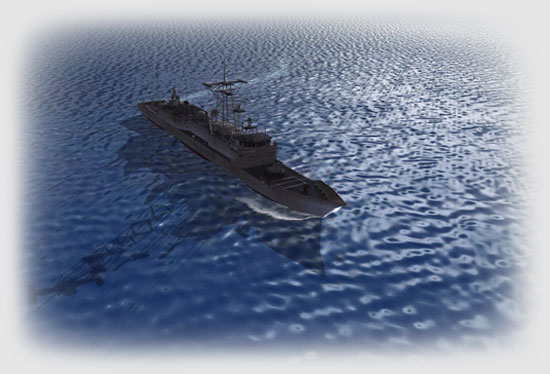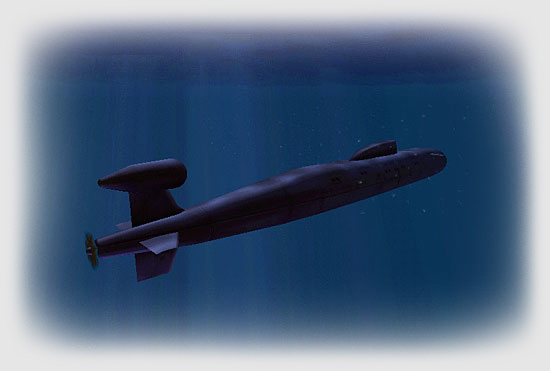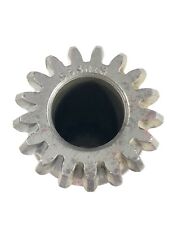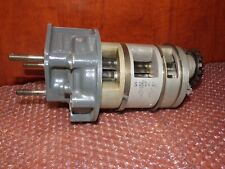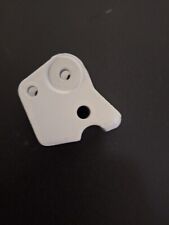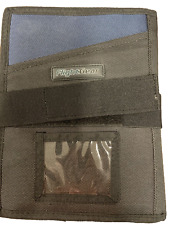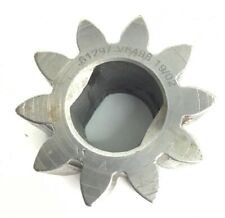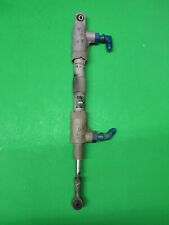Damage sustained in a collision is excessive, as you will read below. The good news is that Sonalysts are aware of the issue. I e-mailed Sonalysts about the excessive collision damage, from the reply I understand that this issue has to do with the update rate of the NavalSimEngine. It periodically checks to see if the platforms are colliding and does some small incremental damage based on speed and thrust. Of course, over time, those increments add up and the number can be quite substantial. Hopefully this issue will be addressed in a future patch.
As an example of the excessive damage, a collision between a Oliver Hazard Perry at 2 knots and a stationary cargo ship will result in over 50% damage to your vessel. Anything faster will result in the total loss of your vessel. In another instance, my Oliver Hazard Perry while traveling at speed in heavy seas nosed dived into the shallow seabed and exploded into a thousand pieces. Other platforms when destroyed simply disappear in a blink of the eye.
The excessive collision damage would not be a major issue if collision were a rare occurrence, sadly it is not, as detailed in the AI section of this review.
None of the damage sustained appears to affect your seaworthiness. In the Kilo submarine (the improved one) having sustained 72% hull damage I submerged to 320 meters, 20 meters past my maximum depth.
With substantial damage, whilst submerged my diligent crew were able to repair the bow and stern planes, forward starboard and port tubes, Propellers, compressed air, starboard and port engines, rudder, surface radar, ESM mast, floating wire, periscope, cylindrical array, countermeasures tube and the snorkel mast. There does not appear to be anything that cannot be repaired whilst submerged.
The concept that a substantial amount of non-lethal damage to the bow followed by a small non-lethal damage to my stern can suddenly make the entire hull fail is absurd. Silent Hunter II was the last simulation to use a ‘%’ figure for the ‘hull’ and it was rightly panned for it. We have to go back to the 1996 and Silent Hunter to see a reasonable implementation of hull damage. The way in which hull damage is modeled ensures that a submarine is always a one hit kill.
The simplistic way in which the damage to the hull is implemented along with the simplistic sailing model also means that the effects are simplistic. Get hit in the bow on the port side with a torpedo in the Oliver Hazard Perry and apart from a reduction in maximum speed and other equipment damage you are free to proceed at maximum speed. No stopping to make the area water tight, no reduction in other stations ability to function etc. Those playing a multiplayer game in a submarine against a player in the Oliver Hazard Perry will at times feel hard done by as demonstrated by this example.
As there is no flooding indicator, coupled with the fact that I have never been lost due to flooding, I can only presume that it is also not included in the damage model.
I would have expected to see this damage model and implementation of repairs in an action style war game and not in a simulation. Either Sonalysts ran out of time to finish the damage model or the game engine’s damage model is not up to the level that would be expected from a simulation of this type.
AI
On my test of 5 AI FFG’s Vs a Kilo submarine I saw some excellent behavior that one would expect under the conditions. In one run, the FFG discovered the Kilo at a distance of 10 nautical miles (a bit far?) and launched an attack at around 4 nautical miles. After a short period, the Kilo become aware of the attack launched two passive countermeasures and two torpedoes at the same time running away at maximum speed.
I did notice that it would appear that the AI submarine would use countermeasures only once. It may launch both at the same time, but I could not see an instance that it launched one on two separate occasions.
Attacks by an AI platform will often result in another platform other than the intended enemy platform being hit. As an example, in the FFG’s Vs a Kilo submarine mission, one FFG launched an attack on the Kilo submarine that was positioned 500 yards to its stern. The result was the torpedoes striking an FFG over 1.3 nautical miles away. The torpedoes never looked as if they were intended for the Kilo submarine. In another instance the Kilo submarine was 380 yards to the FFG’s port side and the two torpedoes hit two FFG’s over 1200 yards away.
In the FFG’s Vs a Kilo submarine it was pleasing to see the Kilo submarine mostly choose the most logical path. No matter how many times I changed the position etc. of the FFG’s, the Kilo mostly always took the best path. I say mostly, as the AI platforms only seem to be able to go forward. When I had setup the FFG’s to totally block the forward paths of the Kilo submarine it did not go back and around.
One downside I did notice is that when replaying the 5 FFG’s and Kilo mission over and over again with no changes the Kilo submarine always went along the exact same path. As discussed below, the lack of lateral movement away from the predetermined course does severely limit the AI’s ability to evade the enemy.
The AI appears to be limited in its abilities to act on its own, that is, without the mission designer telling it how to act. In the FFG’s Vs a Kilo submarine mission I set 5 AI FFG’s to each do a box search with orders to attack the Kilo submarine. Even when the Kilo was discovered at a distance of 10 nautical miles (which seems to be excessive and occurred every time the mission was run), the AI would mostly continue doing it’s thing, with only one unit ever making an attack.
As I have alluded to in the above paragraphs the AI’s ability to pick up the Kilo submarine traveling at 3 knots at a distance of 10 nautical miles, every time, and, with an accuracy of 100% as shown by using ‘show truth’ is reason for concern. Set the sea state to 5, and the distance that the Kilo submarine would be detected was around 5-6 nautical miles.

